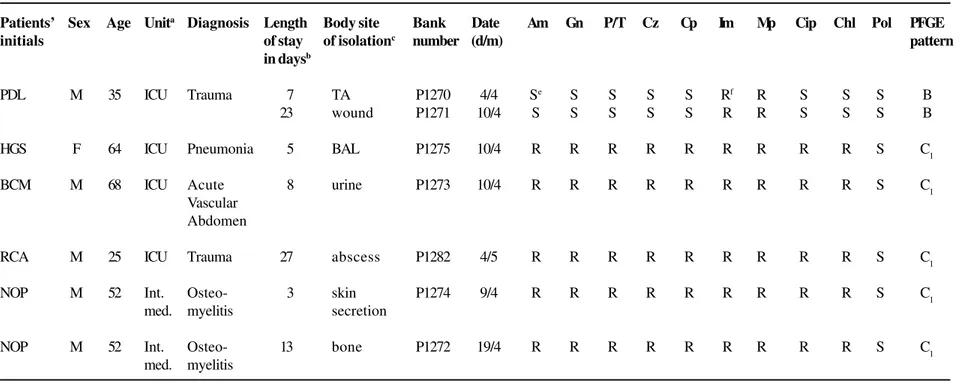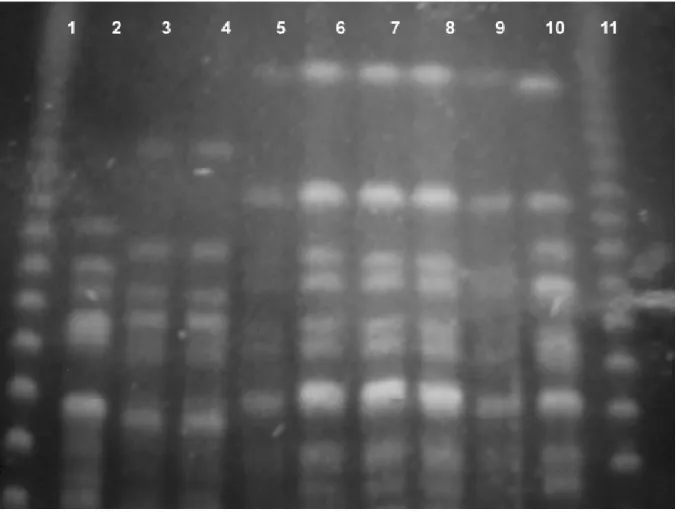Carbapenem-Resistant
Pseudomonas aeruginosa Outbreak
in an Intensive Care Unit of a Teaching Hospital
Ana C. Gales1, Patrícia L. Torres1, Division of Infectious Diseases1, Laboratory of Microbiology, Dominique S. O. Vilarinho3, Renata S. Melo3, São Francisco Universitary Hospital2, São Francisco Claudinéia F. L. Silva2 and Rosângela F. Cereda1 University3, Bragança Paulista, SP, Brazil
The genetic similarity of carbapenem-resistant Pseudomonas aeruginosa strains isolated in the Hospital Universitário São Francisco, Bragança Paulista, São Paulo, Brasil, was evaluated by pulsed field gel electrophoresis (PFGE). A unique clone was detected among 5 of 7 isolates, suggesting that cross-contamination might have played a role in the spread of carbapenem-resistant P. aeruginosa strains. Interestingly, a similar PFGE pattern was encountered in a P. aeruginosa strain isolated from Hospital São Paulo that was used as a PFGE control.
Key Words: Pseudomonas aeruginosa, PFGE, carbapenem.
Received on 15 January 2004; revised 17 July 2004.
Address for correspondence: Dr. Ana Cristina Gales. Av. Oswaldo Assis Gonçalves, 343. Bragança Paulista – São Paulo. Zip code: 12916-120, Brazil. Phone: (011) 4033-6062. Fax: (011) 4033-3540. Email: galesac@aol.com
The Brazilian Journal of Infectious Diseases 2004;8(4):267-271 © 2004 by The Brazilian Journal of Infectious Diseases and Contexto Publishing. All rights reserved.
Pseudomonas aeruginosa is a Gram-negative aerobic bacillus isolated from soil, water, plants, and animals, including humans [1]. The minimal nutritional requirements of P. aeruginosa, its tolerance of a wide variety of physical conditions, and its relative resistance to antimicrobial agents contribute to its ecological success and to its role as an effective opportunistic pathogen [1,2].
Pseudomonas aeruginosa is primarily a nosocomial pathogen, and it rarely affects healthy persons. It is a leading cause of nosocomial infections, ranking first as a cause of nosocomial pneumonia in Brazilian hospitals
[3].In the United States, P. aeruginosa ranked first
among all nosocomial pathogens related to pneumonia in intensive care units reported to the National Nosocomial Infection Surveillance System [4].
Carbapenems generally remain one of the last therapeutic resorts against serious P. aeruginosa infections [5]. However, carbapenem use has been limited by the emergence and the dissemination of
multidrug resistant clones [2]. In the Hospital Universitário São Francisco, HUSF, a 160-bed Brazilian teaching hospital, an increase in the isolation of carbapenem-resistant P. aeruginosa was noticed between March and April 2001. The main aim of this study was to investigate if the increase of
carbapenem-resistant P. aeruginosa isolation was related to the
emergence and spread of an epidemic strain within our institution.
Materials and Methods
Bacterial strains
Seven P. aeruginosa strains were included in the study. They were collected from diverse body sites from five patients hospitalized at HUSF between March and April 2001.
Susceptibility testing
268 BJID 2004; 8 (August)
www.bjid.com.br
ceftazidime, cefepime, imipenem, meropenem, ciprofloxacin, chloramphenicol, and polymyxin B. The antimicrobial susceptibility testing results were interpreted using the NCCLS criteria established for non-Enterobacteriaceae [7]. Quality control was
performed by testing E. coli ATCC 25922,
Staphylococcus aureus ATCC 25923, and P. aeruginosa ATCC 27853.
Genotyping
The P. aeruginosa isolates were typed by pulsed-field gel electrophoresis (PFGE) to determine genetic similarity. The PFGE was performed using SpeI restriction endonucleases and the switch time varied from 5 to 90 seconds, as previously described [8]. Analysis of PFGE patterns was performed by visual inspection of photographs of ethidium bromide-stained gels. The isolates were classified as identical if they shared the same bands, closely related if they differed by one to three bands, and as distinct if they varied by more than three bands [8].
Results
The results of this study were summarized in Table 1. Five carbapenem-resistant P. aeruginosa were collected from four patients hospitalized in the intensive care unit of the HUSF, while the two remaining isolates were isolated from a patient hospitalized in the internal medicine ward. All of the carbapenem-resistant P. aeruginosa strains were isolated between March and April 2001, and they were responsible for causing nosocomial-acquired infections.
Regarding the antimicrobial susceptibility results, two strains collected from the same patient were susceptible to all agents tested except the carbapenems. In contrast, the five remaining carbapenem-resistant P. aeruginosa strains were resistant to all antimicrobial agents tested, except polymyxin B.
Among the seven carbapenem-resistant P. aeruginosa strains, two distinct PFGE patterns were detected. The PFGE pattern C
1 was found in five multidrug resistant P.
aeruginosa. Curiously, the pattern C1 was similar to the pattern C
2 displayed by a carbapenem-resistant P.
aeruginosa isolated from the Hospital São Paulo, HSP, Universidade Federal de São Paulo/EPM, which was included in the PFGE gel as a control (P813).
Discussion
Intensive care units (ICUs) have been clearly noted as endemic settings for P. aeruginosa. Several factors have contributed to this, such as the presence of critically ill patients who need invasive devices, extensive use of antibiotics, and limited number of health care providers [9-12]. In our study, all carbapenem-resistant P. aeruginosa isolates, except two, were collected from patients hospitalized in the ICU. Two isolates were collected from a patient who was hospitalized at the internal medicine ward but had been hospitalized in ICU in November 2000. At that time, the patient was admitted to the ICU due to serious trauma injuries and developed a multidrug-resistant P. aeruginosa acute osteomyelitis in the left femur after a surgical correction of an open fracture.
The epidemiology of P. aeruginosa infections has been studied by the analysis of phenotypic markers, including antimicrobial susceptibility profiles. However, genotypic methods, such as PFGE, are the most important tools to characterize the identity of bacterial strains like P. aeruginosa [8,9]. We observed a good correlation between antimicrobial susceptibility results and PFGE patterns, as all multidrug-resistant P. aeruginosa exhibited an identical PFGE type.
The presence of a clonal strain among the
carbapenem-resistant P. aeruginosa suggested that the
ICU experienced an outbreak due to horizontal transmission. Hands of medical personnel have been considered the major vector of propagation of P. aeruginosa [9-11]. Bertrand et al. showed that 50% of all cases of P. aeruginosa colonization in an ICU were due to cross-colonization [9]. The patient with chronic osteomyelitis could have been the index case since no multi-drug resistant P. aeruginosa isolates belonging to clone C
1 were detected previously to his
www
.bjid.com.br
Pseudomonas aeruginosa
Outbreak in an ICU
Table 1. Charcteristics of carbapenem-resistant Pseudomonas aeruginosa – Patients’ demographic data, antimicrobial susceptibility profiles and PFGE patterns
Susceptibility to Antimicrobial Agentsd
Patients’ Sex Age Unita Diagnosis Length Body site Bank Date Am Gn P/T Cz Cp Im Mp Cip Chl Pol PFGE
initials of stay of isolationc number (d/m) pattern
in daysb
PDL M 35 ICU Trauma 7 TA P1270 4/4 Se S S S S Rf R S S S B
23 wound P1271 10/4 S S S S S R R S S S B
HGS F 64 ICU Pneumonia 5 BAL P1275 10/4 R R R R R R R R R S C1
BCM M 68 ICU Acute 8 urine P1273 10/4 R R R R R R R R R S C1
Vascular Abdomen
RCA M 25 ICU Trauma 27 abscess P1282 4/5 R R R R R R R R R S C1
NOP M 52 Int. Osteo- 3 skin P1274 9/4 R R R R R R R R R S C1
med. myelitis secretion
NOP M 52 Int. Osteo- 13 bone P1272 19/4 R R R R R R R R R S C1
med. myelitis
a. ICU, intensive care unit; Int. Med., internal medicine.
b. Hospital stay in days before the isolation of carbapenem-resistant P. aeruginosa. c. TA, tracheal aspirate; BAL, bronchoalveolar lavage.
d. Am, amikacin; Gn, gentamicin; P/T, piperacillin/tazobactam; Cz, ceftazidime; Cp, cefepime; Im, imipenem; Mp, meropenem; Cip, ciprofloxacin; Chl, chloramphenicol, and Pol, polymyxin B. e. S, susceptible.
270 BJID 2004; 8 (August)
www.bjid.com.br
hospitalization. However, multidrug-resistant P. aeruginosa isolates were detected in the HUSF previously, in November 2000, and they are still
sporadically detected. Thus, clone C1 might have
emerged earlier and persisted in the hospital environment, and occasionally caused infections and outbreaks. Generally, the genotypic results will guide the actions that must be taken by the infection control team, such as eradication of a common environmental source or other control measures to avoid cross-infection [8,9]. After emphasizing compliance to infection control measures, such as handwashing and contact precaution, a reduction of the multidrug-resistant P. aeruginosa isolation was observed in the HUSF.
Figure 1. Pulsed field gel electrophoresis patterns of carbapenem-resistant Pseudomonas aeruginosa. Lanes 1 and 11, DNA molecular marker; lane 2, P. aeruginosa quality control strain 120030; lane 3, P1270; lane 4, P1271; lane 5, P1272; lane 6, P1273; lane 7, P1274; lane 8, P1275; lane 9, P1282; lane 10,
carbapenem-resistant P. aeruginosa control strain P813.
The genetic similarity among carbapenem-resistant P. aeruginosa isolated at HUSF and HSP was a totally unexpected finding. The occurrence of
multidrug-resistant P. aeruginosa strains belonging to a unique
have a better understanding about the dissemination of carbapenem-resistant P. aeruginosa isolates among Brazilian hospitals, it would be important to evaluate a larger number of P. aeruginosa isolates collected from distinct hospitals located in other Brazilian regions as well.
We confirmed the importance of P. aeruginosa as an important nosocomial pathogen in Brazilian hospitals and we emphasize that handwashing is a valuable measure to control an outbreak.
Acknowledgements
We are very grateful to Mariana Castanheira and Suzane Silbert from the Laboratório Especial de Microbiologia Clínica, Universidade Federal de São Paulo/ EPM for performing the PFGE procedure.
References
1. Kinska D.L., Guilligan P.H. Pseudomonas. In: Murray P.R., Baron E.J., Pfaller M.A., et al [eds.]. Manual of Clinical Microbiology. Washington, DC: ASM Press, 1999. 2. Gales A.C., Jones R.N., Turnidge J.,Rennie R., Ramphal
R. Characterization of Pseudomonas aeruginosa
Infection Isolates: Occurrence Rates, Antimicrobial Susceptibility Patterns, and Molecular Typing from the Global SENTRY Antimicrobial Surveillance Program, 1997-1999. Clin Infect Dis 2001;32(Suppl2):146-55.
3. Sader H.S., Gales A.C., Pfaller M.A., et al. Pathogen frequency and resistance patterns in Brazilian hospitals: summary of results from three years of the SENTRY Antimicrobial Surveillance Program. Braz J Infect Dis 2001;5:200-14.
4. Richards M.J., Edwards J.R., Culver D.H., Gaynes R.P. Nosocomial infections in medical intensive care units in the United States. National Nosocomial Infections Surveillance System. Crit Care Med 1999;27:887-92. 5. Livermore D.M. Multiple mechanisms of antimicrobial
resistance in Pseudomonas aeruginosa: our worst nightmare? Clin Infect Dis 2002;34:634-40.
6. National Committee for Clinical Laboratory Standards. Performance standards for disk susceptibility tests; seventh edition. Approved Standard M2–A7. NCCLS, Wayne, PA, 2000.
7. National Committee for Clinical Laboratory Standards. Performance standards for antimicrobial susceptibility testing; twelfth Informational Supplement. M100-S12. NCCLS, Wayne, PA. 2002.
8. Pfaller, M. A., Hollis R.J., Sader H.S. Chromosomal restriction fragment analysis by pulsed-field gel electrophoresis. In: Isenberg H.D. ed.. Clinical Microbiology Procedures Handbook. Washington, DC: ASM Press, 1992.
9. Bertrand X., Thouverez M., Talon D., et al. Endemicity, molecular diversity and colonisation routes of
Pseudomonas aeruginosa in intensive care units. Intensive Care Méd 2001;27:1263-8.
10. Carmeli Y., Troillet N., Eliopoulos G.M., Samore M.H. Emergence of antibiotic-resistant Pseudomonas aeruginosa: comparison of risks associated with different antipseudomonal agents. Antimicrob Agents Chemother 1999;43:1379-82.
11. Kerr J.R., Martin H., Chadwick M.V. et al. Evidence against transmission of Pseudomonas aeruginosa by hands and stethoscopes in a cystic fibrosis unit. J Hosp Infect 2002;50:324-26.
12. Bukholm G., Tannaes T., Kjelsberg A.B., Smith-Erichsen N. An outbreak of multidrug-resistant Pseudomonas aeruginosa associated with increased risk of patient death in an intensive care unit. Infect Control Hosp Epidemiol 2002;23:441-6.
13. Pellegrino F.L., Teixeira L.M., Carvalho M.D. et al. Occurrence of a multidrug-resistant Pseudomonas aeruginosa clone in different hospitals in Rio de Janeiro, Brazil. J Clin Microbiol 2002;40:2420-4. 14. Gales A.C., Menezes L.C., Silbert S., Sader H.S.

